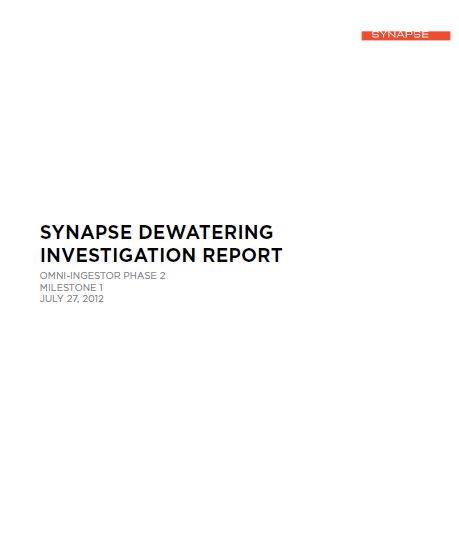Synapse Dewatering Investigation Report - Omni-Ingestor Phase 2, Milestone 1
Frederick, R., Gurski, T. (2012)

Published in: 2012
Publisher:
Consultancy report by Synapse (USA) commissioned by Bill & Melinda Gates Foundation, Seattle, USA
Author:
Frederick, R., Gurski, T.
Uploaded by:
SuSanA secretariat
Partner profile:
common upload
12008 Views
153 Downloads
Content - Summary
This document explores various available dewatering technologies, and analyzes their applicability for separating the liquid and solid components of septic holding tanks. The purpose of this exercise is to identify ways to reduce the quantity of solid materials that must be transported away after desludging a pit or septic tank, presuming the produced water could be easily treated and safely reused or discharged on site or nearby. The technologies reviewed are discussed for their applicability to a specific project concept; reviews do not address more general applicability. For others with dewatering needs, however, this review may provide some directional guidance.
This report was created as part of the development effort for the Omni-Ingestor: a modular equipment set designed to extract and process fecal sludge from pit latrines and septic tanks. This work is being performed under a contract with the Bill and Melinda Gates Foundation’s Water, Sanitation, and Hygeine department. Its purpose is to explore available dewatering technologies, and analyze their applicability towards the Omni-Ingestor design. Its intention is neither to promote, nor to discredit, any specific vendor, technology, or manufacturer.
One of the critical capabilities of the Omni-Ingestor is the ability to separate the liquid and solid components of septic holding tanks to reduce the quantity of material that must be transported away. The system in the Omni-Ingestor must meet several requirements, as outlined in the “Ejected Material Guidelines D5.pdf” document.1 To summarize, the requirements are:
• Input liquid septage will be between 0% and 5% solids.
• Output liquid after separation and dewatering must have:
o Less than 20mg/l TSS
o Less than 20mg/l BOD
o Less than 50mg/l COD
o Turbidity less than 200 NTU
o pH between 6.0 and 9.0
• Output solids after dewatering must have:
o All free water be removed (TS value of 12%-15%)
- The target TS will be 25%
- Higher TS values are permitted but the cost of the additional performance will need to be relatively low.
• The benefits of the system must be economically justifiable.
The system(s) Synapse recommends pursuing meet or come close to meeting these targets. In cases where they do not meet the target requirements, Synapse holds the position that increasing the performance to meet the requirements is either possible through a redesign of the system, reducing system cost via mass production and DFM, or is not practical and would result in a substantial increase in system cost.
Bibliographic information
Frederick, R., Gurski, T. (2012). Synapse Dewatering Investigation Report - Omni-Ingestor Phase 2, Milestone 1. Consultancy report by Synapse (USA) commissioned by Bill & Melinda Gates Foundation, Seattle, USA
Filter tags
English Faecal sludge treatment processes Fundamental research and engineering North America















